
Gun truck
Encyclopedia
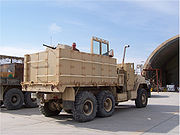
Improvised fighting vehicle
An improvised fighting vehicle is a combat vehicle resulting from modifications to a civilian or military non-combat vehicle in order to give it a fighting capability...
used by units of regular armies or other official government armed forces, based on a conventional cargo truck
Truck
A truck or lorry is a motor vehicle designed to transport cargo. Trucks vary greatly in size, power, and configuration, with the smallest being mechanically similar to an automobile...
, that is able to carry a large weight of weapons and armor. They have mainly been used by regular armies to escort military convoys in regions subject to ambush by guerrilla
Guerrilla warfare
Guerrilla warfare is a form of irregular warfare and refers to conflicts in which a small group of combatants including, but not limited to, armed civilians use military tactics, such as ambushes, sabotage, raids, the element of surprise, and extraordinary mobility to harass a larger and...
forces.
World War II
When the prospect of a German invasionOperation Sealion
Operation Sea Lion was Germany's plan to invade the United Kingdom during the Second World War, beginning in 1940. To have had any chance of success, however, the operation would have required air and naval supremacy over the English Channel...
of the United Kingdom seemed likely, the British Army designed and built an improvised armored vehicle, the Bedford OXA
Bedford OXA
The Bedford OXA was improvised British heavy armoured car built during World War II by mounting an armoured body onto a Bedford OXD 1.5 ton truck chassis. 948 units were built in 1940-1941. The vehicle was used by British Home Guard units until 1942....
. It was based on the one and a half ton OXD truck, and was upgraded with armor plate, and armed with a .55 in anti-tank rifle
Rifle, Anti-Tank, .55 in, Boys
The Rifle, Anti-Tank, .55in, Boys commonly known as the "Boys Anti-tank Rifle" , was a British anti-tank rifle in use during World War II....
and a Bren gun. Slightly less than a thousand were built by 1941, and they were employed by the British Home Guard
British Home Guard
The Home Guard was a defence organisation of the British Army during the Second World War...
.
Other British examples from the invasion-scare period were the Armadillo armoured fighting vehicle
Armadillo armoured fighting vehicle
The Armadillo was an extemporised armoured fighting vehicle produced in Britain during the invasion crisis of 1940-1941. Based on a number of standard lorry chassis, it comprised a wooden fighting compartment protected by a layer of gravel and a driver's cab protected by mild steel plates...
and the Bison concrete armoured lorries
Bison concrete armoured lorries
The Bison was an extemporised armoured fighting vehicle frequently characterised as a mobile pillbox. Bisons were produced in Britain during the invasion crisis of 1940-1941. Based on a number of different lorry chassis, it featured a fighting compartment protected by a layer of concrete. Bisons...
. Both were conventional trucks fitted with improvised armour, in the case of the Bison, a concrete fighting-compartment was carried, essentially making a mobile pillbox. The Armadillo used two walls of wood, with the space between filled with gravel. Both vehicles had poor mobility and were employed for airfield defense by the Royal Air Force
Royal Air Force
The Royal Air Force is the aerial warfare service branch of the British Armed Forces. Formed on 1 April 1918, it is the oldest independent air force in the world...
.
In the event of a surprise, airborne attack, Bisons would deploy a short distance to the key points of the airfield and probably fight from static positions, positions where fixed defenses often could not be constructed as they would impede aircraft movement during day–to–day operations. The Armadillo's mobility, while poor, was better than the Bison's and it was intended they would take on a mobile role similar to a conventional armoured vehicle.
Vietnam War
During the Vietnam WarVietnam War
The Vietnam War was a Cold War-era military conflict that occurred in Vietnam, Laos, and Cambodia from 1 November 1955 to the fall of Saigon on 30 April 1975. This war followed the First Indochina War and was fought between North Vietnam, supported by its communist allies, and the government of...
, it was the mission of the US Army Transportation Corps
United States Army Transportation Corps
The Transportation Corps was established 31 July 1942 by Executive Order 9082. The Transportation Corps is a combat service support branch of the U.S. Army, and was headquartered at Fort Eustis, Virginia, but has now moved to Fort Lee, Virginia. The Transportation Corps is responsible for the...
to ferry supplies from the coastal ports of Qui Nhon
Qui Nhon
Qui Nhơn , also Quy Nhơn, is a coastal city in Binh Dinh province in central Vietnam. It is composed of 16 wards and five communes with a total of 286 km². Quy Nhon is the capital of Bình Định province. As of 2009 its population was 280,900. Historically, the commercial activities of the city...
and Cam Ranh Bay
Cam Ranh Bay
Cam Ranh Bay is a deep-water bay in Vietnam in the province of Khánh Hòa. It is located at an inlet of the South China Sea situated on the southeastern coast of Vietnam, between Phan Rang and Nha Trang, approximately 290 kilometers / 180 miles northeast of Hồ Chí Minh City / Saigon.Cam Ranh is...
to inland bases located at Bong Son, An Khe, Pleiku
Pleiku
Pleiku is a town in central Vietnam, located in that nation's central highland region. It is the capital of the Gia Lai Province; it is inhabited primarily by the Bahnar and Jarai ethnic groups, sometimes known as the Montagnards or Degar....
, Da Lat, and Buon Ma Thuot
Buon Ma Thuot
Buôn Ma Thuột or sometimes Buon Ma Thuat or Ban Mê Thuột, is the capital city of Dak Lak Province, in the Central Highlands of Vietnam. Its population is approximately 300,000...
. The logistical requirements of the MACV were huge, and 200-truck convoys were not uncommon. These formations were tempting targets for Viet Cong
National Front for the Liberation of South Vietnam
The Vietcong , or National Liberation Front , was a political organization and army in South Vietnam and Cambodia that fought the United States and South Vietnamese governments during the Vietnam War . It had both guerrilla and regular army units, as well as a network of cadres who organized...
guerrilla groups, who often sprung ambush
Ambush
An ambush is a long-established military tactic, in which the aggressors take advantage of concealment and the element of surprise to attack an unsuspecting enemy from concealed positions, such as among dense underbrush or behind hilltops...
es in remote areas.
One unit that often fell victim to such attacks was the 8th Transportation Group, based in Qui Nhon. The stretch of Route 19 between An Khe and the Mang Giang Pass became known to them as "Ambush Alley" as incidents occurred there on an almost daily basis.
Providing security for convoys proved virtually impossible, as the Military Police units whose task it was did not have the manpower or equipment to control the whole highway. Other military units only controlled the stretch of road within their designated area of operations, and for much of the way, it fell onto the transport units to ensure their own security. At first they did this with armed jeep
Jeep
Jeep is an automobile marque of Chrysler . The first Willys Jeeps were produced in 1941 with the first civilian models in 1945, making it the oldest off-road vehicle and sport utility vehicle brand. It inspired a number of other light utility vehicles, such as the Land Rover which is the second...
s, but these rapidly proved inadequate, in the face of improved Viet Cong weaponry and tactics.
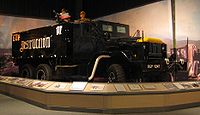
M35 2-1/2 ton cargo truck
The M35 family of trucks is a long-lived vehicle initially deployed by the United States Army, and subsequently utilized by many nations around the world. A truck in the 2½ ton weight class, it was one of many vehicles in U.S...
, protected by a barrier of sandbag
Sandbag
A sandbag is a sack made of hessian/burlap, polypropylene or other materials that is filled with sand or soil and used for such purposes as flood control, military fortification, shielding glass windows in war zones and ballast....
s, and armed with two M60 machine gun
M60 machine gun
The M60 is a family of American general-purpose machine guns firing 7.62×51mm NATO cartridges from a disintegrating belt of M13 links...
s. Hardened convoys were smaller than previously, being composed of only 100 trucks, and their security detail was increased until there was one gun truck for every 10 transport trucks.
In the event of an ambush, their role was to drive into the "kill zone" during the first few minutes of the attack, and saturate the attackers with their fire power
Fire power
Firepower is the military capability to direct force at an enemy. It is not to be confused with the concept of rate of fire, which describes cycling of the firing mechanism in a weapon system. It involves the whole range of potential weapons...
. Early designs proved flawed, as the sandbag protections quickly became waterlogged in the frequent rains, weighing down the whole vehicle. They were later replaced with ad hoc
Ad hoc
Ad hoc is a Latin phrase meaning "for this". It generally signifies a solution designed for a specific problem or task, non-generalizable, and not intended to be able to be adapted to other purposes. Compare A priori....
steel armor plating, salvaged from scrap yards. The crew consisted of a driver, two gunners, a non-commissioned officer
Non-commissioned officer
A non-commissioned officer , called a sub-officer in some countries, is a military officer who has not been given a commission...
, and sometimes a grenadier armed with an M79 grenade launcher
M79 grenade launcher
The M79 grenade launcher is a single-shot, shoulder-fired, break-action grenade launcher that fires a 40x46mm grenade which used what the US Army called the High-Low Propulsion System to keep recoil forces low, and first appeared during the Vietnam War...
.
On November 24, 1967, during an engagement in "Ambush Alley", a group of gun trucks managed to thwart an ambush. The convoy lost six transport trucks and four gun trucks damaged or destroyed, and several drivers were killed and wounded, but the Viet Cong lost 41 KIA
Killed in action
Killed in action is a casualty classification generally used by militaries to describe the deaths of their own forces at the hands of hostile forces. The United States Department of Defense, for example, says that those declared KIA need not have fired their weapons but have been killed due to...
and were forced to withdraw.
Despite the increased security, transportation units still came under attack, forcing the gun truck units to improve the design of their vehicles. The two-and-a-half-ton trucks were underpowered, and the addition of armor and weapons slowed them down, leading to their replacement by five-ton cargo trucks that formed the basis for larger gun trucks. The improvised nature of these vehicles meant they varied considerably in appearance. They were given colourful nicknames such as "Duce is Wild," "Cold Sweat"," "Iron Butterfly" or "Pandemonium" that were often painted on the sides in large letters.
Their armament consisted of various combinations of weapons including M60s, .50-calibre machine guns, and XM 134 minigun
Minigun
The Minigun is a 7.62 mm, multi-barrel heavy machine gun with a high rate of fire , employing Gatling-style rotating barrels with an external power source...
s. Anti-aircraft weapons such as the Bofors 40 mm gun
Bofors 40 mm gun
The Bofors 40 mm gun is an anti-aircraft autocannon designed by the Swedish defence firm of Bofors Defence...
, or quadmount
Quadmount
The M45 Quadmount was a weapon mounting consisting of four M2 Browning machine guns mounted in pairs on each side of an electrically powered turret. It was built by the Maxon Manufacturing Co...
.50 cal. machine guns were also used. Most of these were obtained by cannibalising damaged infantry weapons that the transport units often carried on their return trip.
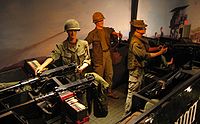
South Vietnam
South Vietnam was a state which governed southern Vietnam until 1975. It received international recognition in 1950 as the "State of Vietnam" and later as the "Republic of Vietnam" . Its capital was Saigon...
ese army. Sometimes a double thickness of armour was fitted, with a space between each layer, to provide protection against anti-tank rockets. In other cases, the entire hull of an M113 armoured personnel carrier
M113 armored personnel carrier
The M113 is a fully tracked armored personnel carrier that has formed the backbone of the United States Army's mechanized infantry units from the time of its first fielding in Vietnam in April 1962. The M113 was the most widely used armored vehicle of the U.S...
was mounted on the bed of a five-ton truck, thus providing all-round protection for the crew. Despite their aggressive names, gun trucks were strictly defensive weapons, being used only for convoy escort and perimeter defence duties.
Gun trucks suffered from several drawbacks. The added weight of armour, weapons and ammunition increased fuel consumption, as well as creating maintenance problems and reducing the durability of the truck frames. Also, the personnel assigned as crew to the security vehicles were no longer available for transport duties, thus reducing the lift capacity of each unit. Despite this, they were generally regarded as a success.
In all, an estimated 300 to 400 trucks were transformed in this way. They were intended as a temporary solution, but the Transportation Corps never received enough of their proposed replacement, the V-100 armoured car, so the gun trucks continued to serve until the end of the American involvement in Vietnam, in 1973. With the end of the Vietnam War, the need for such vehicles disappeared and most were either scrapped or returned to cargo carrying. One truck, an M54
M54 (truck)
The M54 Truck, officially designated Truck, Cargo, 5 Ton 6×6 M54, is a heavy cargo truck developed by, and deployed primarily with, the United States Armed Forces. The vehicle is a member of the M39 series of trucks. It is rated for five-ton cargo loads, cross-country, and ten-ton cargo loads,...
named by its crew "Eve of Destruction," has been restored and is on display at the Army Transportation Museum
U.S. Army Transportation Museum
The U.S. Army Transportation Museum is a United States Army museum of vehicles and other transportation-related equipment and memorabilia. It is located on the grounds of Fort Eustis, Virginia, in Newport News, on the Virginia Peninsula.-History:...
at Fort Eustis, Virginia
Virginia
The Commonwealth of Virginia , is a U.S. state on the Atlantic Coast of the Southern United States. Virginia is nicknamed the "Old Dominion" and sometimes the "Mother of Presidents" after the eight U.S. presidents born there...
.
Iraq War
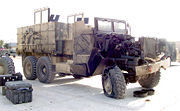
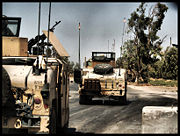
Nasiriyah
Nasiriyah is a city in Iraq. It is on the Euphrates about 225 miles southeast of Baghdad, near the ruins of the ancient city of Ur. It is the capital of the province of Dhi Qar...
, losing eleven soldiers killed and five taken prisoner, including Pfc. Jessica Lynch
Jessica Lynch
Jessica Dawn Lynch is a former Private First Class in the United States Army Quartermaster Corps. Lynch served in Iraq during the 2003 invasion by U.S. and allied forces. On March 23, 2003 she was injured and captured by Iraqi forces but was recovered on April 1 by U.S...
. During the later phase of the war, road convoys were considered "soft" targets, and frequently came under attack by Iraqi insurgents
Iraqi insurgency
The Iraqi Resistance is composed of a diverse mix of militias, foreign fighters, all-Iraqi units or mixtures opposing the United States-led multinational force in Iraq and the post-2003 Iraqi government...
. This led to the re-invention of the gun truck, with the first modified examples, based on M939
M939 Truck
The M939 series 5-ton 6x6 truck is a family of United States military logistical transportation trucks which was designed in the late 1980s and has been in service ever since. About 32,000 M939 series trucks are in service...
five-ton trucks, entering service in August 2003.
In April 2004, Leaders of the US Army Reserve 375th Transportation Group and the 812th Transportation Battalion formed a special provisional unit - the 518th "Gun Truck" Company. Based in Camp Navistar (located on the Kuwait side of the border Near Safwan, Iraq), this company acquired 35 humvees and five M939
M939 Truck
The M939 series 5-ton 6x6 truck is a family of United States military logistical transportation trucks which was designed in the late 1980s and has been in service ever since. About 32,000 M939 series trucks are in service...
five-ton trucks, and modified them with improvised armor and .50 calibre machine-guns. With many Reserve and National Guard combat arms units already converting and performing Convoy Security Escort service while deployed to Iraq, the need for a special Gun Truck unit proved unfeasible and the unit disbanded in April, 2005.
The use of improvised fighting vehicles, protected by the so-called "Hillbilly armor", quickly became a political issue, with the Bush administration coming under criticism for having sent the U.S. military to fight without adequate equipment. The idea of producing a standardised gun truck was instigated by Representative
United States House of Representatives
The United States House of Representatives is one of the two Houses of the United States Congress, the bicameral legislature which also includes the Senate.The composition and powers of the House are established in Article One of the Constitution...
Duncan Hunter
Duncan Hunter
Duncan Lee Hunter is an American politician. He was a Republican member of the House of Representatives from California's 52nd, 45th and 42nd districts from 1981 to 2009....
(R.
Republican Party (United States)
The Republican Party is one of the two major contemporary political parties in the United States, along with the Democratic Party. Founded by anti-slavery expansion activists in 1854, it is often called the GOP . The party's platform generally reflects American conservatism in the U.S...
-Calif.
California
California is a state located on the West Coast of the United States. It is by far the most populous U.S. state, and the third-largest by land area...
), chairman of the House Armed Services Committee
United States House Committee on Armed Services
thumb|United States House Committee on Armed Services emblemThe U.S. House Committee on Armed Services, commonly known as the House Armed Services Committee, is a standing committee of the United States House of Representatives...
, despite the reluctance of some Army superior officers.
Developed with the help of Vietnam veterans by the Lawrence Livermore National Laboratory
Lawrence Livermore National Laboratory
The Lawrence Livermore National Laboratory , just outside Livermore, California, is a Federally Funded Research and Development Center founded by the University of California in 1952...
, the resulting armored box (dubbed the "Hunter box") was intended for use on five-ton trucks. Their armor protection was composed of high-grade steel plating, fiberglass
Fiberglass
Glass fiber is a material consisting of numerous extremely fine fibers of glass.Glassmakers throughout history have experimented with glass fibers, but mass manufacture of glass fiber was only made possible with the invention of finer machine tooling...
and ballistic glass, while the armament consisted of two to four heavy machine-guns.
The first prototype was completed in March 2004, and shipped to Iraq in July 2004, after which production began at a slow rate, with 35 units in service by July 2005. As of September 2007, a total of 100 kits have been produced for Iraq, and 18 for use in Afghanistan
Afghanistan
Afghanistan , officially the Islamic Republic of Afghanistan, is a landlocked country located in the centre of Asia, forming South Asia, Central Asia and the Middle East. With a population of about 29 million, it has an area of , making it the 42nd most populous and 41st largest nation in the world...
. The "Hunter boxes" apparently proved popular with U.S. troops, but were criticized by senior officers for their lack of overhead protection, and for being top-heavy, however few cases exist to prove their doubts in this equipment.
Up-armor kits were also produced for the standard Humvee gun truck. The soldiers appreciated the much needed armored protection but the extra weight of the up-armor kits slowed the Humvee's acceleration and speed substantially. The modified heavier vehicle's sluggishness could not match the manoeuvre capabilities of the insurgent vehicles.
Similar vehicles
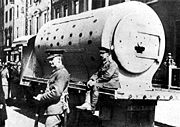
- During the Easter RisingEaster RisingThe Easter Rising was an insurrection staged in Ireland during Easter Week, 1916. The Rising was mounted by Irish republicans with the aims of ending British rule in Ireland and establishing the Irish Republic at a time when the British Empire was heavily engaged in the First World War...
in 1916, the British Army used a truck fitted with an armoured body. This was constructed from the smokeboxSmokeboxA smokebox is one of the major basic parts of a Steam locomotive exhaust system. Smoke and hot gases pass from the firebox through tubes where they pass heat to the surrounding water in the boiler. The smoke then enters the smokebox, and is exhausted to the atmosphere through the chimney .To assist...
es of several steam locomotives. Gun-slits were cut in the body to allow troops to fire out. Painted, black, dummy gun-slits were also applied to confuse snipers.
- During the Soviet war in AfghanistanSoviet war in AfghanistanThe Soviet war in Afghanistan was a nine-year conflict involving the Soviet Union, supporting the Marxist-Leninist government of the Democratic Republic of Afghanistan against the Afghan Mujahideen and foreign "Arab–Afghan" volunteers...
, Soviet convoys were frequently ambushed by AfghanAfghanistanAfghanistan , officially the Islamic Republic of Afghanistan, is a landlocked country located in the centre of Asia, forming South Asia, Central Asia and the Middle East. With a population of about 29 million, it has an area of , making it the 42nd most populous and 41st largest nation in the world...
mujahideenMujahideenMujahideen are Muslims who struggle in the path of God. The word is from the same Arabic triliteral as jihad .Mujahideen is also transliterated from Arabic as mujahedin, mujahedeen, mudžahedin, mudžahidin, mujahidīn, mujaheddīn and more.-Origin of the concept:The beginnings of Jihad are traced...
guerillas. The rebel groups often sited their ambush parties on surrounding heights, above the maximum elevation of the main weapons of the tankTankA tank is a tracked, armoured fighting vehicle designed for front-line combat which combines operational mobility, tactical offensive, and defensive capabilities...
s and APCArmoured personnel carrierAn armoured personnel carrier is an armoured fighting vehicle designed to transport infantry to the battlefield.APCs are usually armed with only a machine gun although variants carry recoilless rifles, anti-tank guided missiles , or mortars...
s employed as convoy escorts. As a stop-gap solution to this problem, the Soviets fitted twin-barrelled ZU-23-2ZU-23-2The ZU-23-2, also known as ZU-23, is a Soviet towed 23 mm anti-aircraft twin-barreled autocannon. ZU stands for Zenitnaya Ustanovka - anti-aircraft mount.-Development history:...
anti-aircraft guns onto KamazKamazKAMAZ is a Russian truck manufacturer located in Naberezhnye Chelny, Tatarstan, Russian Federation. KAMAZ opened their doors in 1976...
trucks, with tents to camouflage the armaments. These vehicles possessed extreme fire-power, but they lacked armour, and the crew were exposed to machine-gun and small-arms fire.
See also
- Improvised vehicle armourImprovised vehicle armourImprovised vehicle armour is vehicle armour added in the field that was not originally part of the design or centrally planned.Improvised vehicle armour has appeared on the battlefield for as long as there have been armoured vehicles in existence. In World War II, U.S. tank crews welded spare...
- Improvised fighting vehicleImprovised fighting vehicleAn improvised fighting vehicle is a combat vehicle resulting from modifications to a civilian or military non-combat vehicle in order to give it a fighting capability...
- TechnicalTechnical (fighting vehicle)A technical is a type of improvised fighting vehicle, typically a civilian or military non-combat vehicle, modified to provide an offensive capability similar to a military gun truck...
- Motorised InfantryMotorised infantryIn NATO and most other western countries, motorised infantry is infantry which is transported by trucks or other motor vehicles. It is distinguished from mechanized infantry, which is carried in armoured personnel carriers, infantry combat vehicles, or infantry fighting vehicles...
- PorteePorteeA portee is a truck that carries a gun on its bed, such that the gun is not affixed permanently to the vehicle, can be quickly unloaded, and can be fired from the truck....
- Larry G. DahlLarry G. DahlLarry Gilbert Dahl was a United States Army soldier and a recipient of the United States military's highest decoration—the Medal of Honor—for his actions in the Vietnam War.-Biography:...
, a Vietnam gun truck crew member who was awarded the Medal of HonorMedal of HonorThe Medal of Honor is the highest military decoration awarded by the United States government. It is bestowed by the President, in the name of Congress, upon members of the United States Armed Forces who distinguish themselves through "conspicuous gallantry and intrepidity at the risk of his or her...
Further reading
- Road Hunter in the Land between the Rivers, James E. Lewandowski. A gun truck soldier's memoir of the Iraq War. ISBN 978-1419670626.
External links
- Vietnam-era gun trucks hold special meaning for MTMCer
- Air Force gun trucks deliver the goods
- Gun Truck Articles at GlobalSecurity.org
- Guntrucks of Ambush Alley—Vietnam-era Gun Trucks of the US Army's 8th Transportation Group
- Vietnam-era gun truck replicas honor Vietnam Veterans

